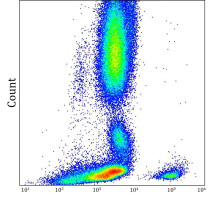ARG43858
anti-CD37 antibody [MB-1] (PE)
anti-CD37 antibody [MB-1] (PE) for Flow cytometry and Human
Overview
| Product Description | PE-conjugated Mouse Monoclonal antibody recognizes CD37 |
|---|---|
| Tested Reactivity | Hu |
| Tested Application | FACS |
| Host | Mouse |
| Clonality | Monoclonal |
| Clone | MB-1 |
| Isotype | IgG1 kappa |
| Target Name | CD37 |
| Antigen Species | Human |
| Immunogen | Lymph node cells |
| Conjugation | PE |
| Protein Full Name | Leukocyte antigen CD37 |
| Alternate Names | CD37; CD37 Molecule; TSPAN26; Leukocyte Antigen CD37; Tetraspanin-26; CD37 Antigen; Tspan-26; Cell Differentiation Antigen 37; Leukocyte Surface Antigen CD37; GP52-40 |
Application Instructions
| Application Suggestion |
|
||||
|---|---|---|---|---|---|
| Application Note | * The dilutions indicate recommended starting dilutions and the optimal dilutions or concentrations should be determined by the scientist. |
Properties
| Form | Liquid |
|---|---|
| Purification | Protein-A affinity chromatography |
| Buffer | PBS (pH 7.4) and 15 mM Sodium azide |
| Preservative | 15 mM Sodium azide |
| Storage Instruction | Protect from prolonged exposure to light. Do not freeze. |
Bioinformation
| Database Links | |
|---|---|
| Gene Symbol | CD37 |
| Gene Full Name | CD37 Molecule |
| Background | The protein encoded by this gene is a member of the transmembrane 4 superfamily, also known as the tetraspanin family. Most of these members are cell-surface proteins that are characterized by the presence of four hydrophobic domains. The proteins mediate signal transduction events that play a role in the regulation of cell development, activation, growth and motility. This encoded protein is a cell surface glycoprotein that is known to complex with integrins and other transmembrane 4 superfamily proteins. It may play a role in T-cell-B-cell interactions. Alternate splicing results in multiple transcript variants encoding different isoforms. |
| Cellular Localization | Membrane |
| Calculated MW | 32 kDa |
| PTM | Glycoprotein |
Images (1) Click the Picture to Zoom In






